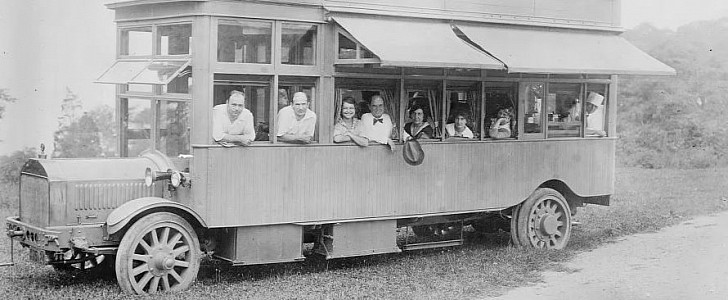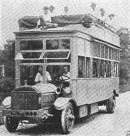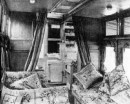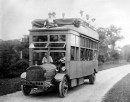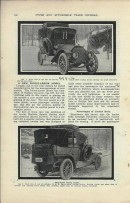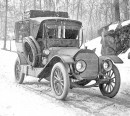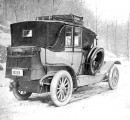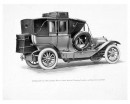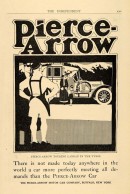Recreational vehicles, whether they’re small vans or oversize buses, or anything in between, would probably not be as popular today as they are, had it not been for one Mr. Roland R. Conklin and his Gypsy Van.
The Gypsy Van is an iconic 1915 RV considered the first-ever motorized caravan to go on an extended trip across the United States and, because of it, launch the RV revolution. The name is actually a misnomer, since there was nothing “gypsy” about it, and it bore no resemblance to what we’d call a van today. This was a double-decker luxury apartment on wheels, and it included fancy amenities even by today’s standards, when we know that money might not buy happiness but it can buy outrageously furnished mobile homes.
The Gypsy Van is (and was) the very definition of chutzpah and luxury, at a time when freedom on the road meant traveling by train or, at best, camping, and neither variant was too comfortable or family-friendly. It was the creation of Roland R. Conklin, who came from one of the wealthiest families in the United States, thanks to their diverse businesses. One of these businesses was the Roland Conklin Gas-Electric Motor Bus Company, allowing Conklin the chance to observe that the country’s roads could use some modernizing.
Because of his experience with bus coaches and a desire to demonstrate the need for improved infrastructure, Conklin built the Gypsy Van, which he decided to take on a 5,000-mile (8,047-km), three-month, transcontinental journey from New York to San Francisco. The basis was a three-ton Packard truck, modified to sleep up to eight people in bunk beds (and more on improvised berths), and to seat as many as 17. If you’re impressed by the large number of occupants, just wait until you hear about the creature comforts onboard.
Conklin set out for the journey himself, with the original party including his wife, their two kids, two nephews and a friend, a governess, a cook, and two chauffeurs, one of whom was also a mechanic. The Gypsy Van encountered problems right away, becoming stuck in mud on its second day on the road, and requiring local assistance for the recovery. Urgent business matters also changed the initial schedule, which meant that the landyacht was shipped for a portion of the journey, before the final leg was completed.
Because this was an unprecedented endeavor in an unprecedented motorized home, the Gypsy Van was covered obsessively in the media at the time. This leaves us with detailed descriptions of the build, if not with sufficient photos or drawings, let alone video.
The Gypsy Van was 21 feet long, 7.5 feet wide and 6.5 feet high (6.4 x 2.3 x 2 meters), and had 44 windows, each one opening to the outside, with matching velvet curtains and screens, and awnings with framing that expanded available space and allowed for outdoor sleeping. The lower level was divided in two compartments, each with multiple functionality. The main entrance was at the rear, through a wooden door with a retractable step, and gave directly into the kitchen. There was an icebox that could hold supplies for one full week for 8 people, a retractable sink, a burner and oven, and pantry. A dining table hung from the ceiling and would expand when needed, and there was a hidden bath with shower and a porcelain sink. The water tanks were placed on the roof, and there was both hot and cold water – and even filtered ice water for drinking, which was first passed through the icebox.
The main compartment held two sofas and four retractable (Pullman-style) bunk beds attached to the ceiling, with each bunk having privacy curtains, individual lighting, and wardrobe. A dining table for more formal occasions was available, while the wooden staircase leading up to the roof deck could convert into a cards table with a special-made surface. Behind it was a bookcase and a retractable writing station, with all the necessary stationery.
The roof deck had rails that folded down for easier bridge clearance, and storage lockers with cushions that served as seats, and a small vegetable garden. People could either ride on top or sleep here, as the deck had a cover to protect from the elements as well. Inside the lockers was fishing gear and guns for hunting, clothes and mattresses. Also there was a motorcycle, which functioned like a tender for a watercraft, in that it could be sent out to inspect the road or a bridge, or to call for help. The bike would be lowered onto the ground by crane, which could also be used to haul up supplies.
The Gypsy Van had a water pump, two generators, a battery, a winch, custom suspension and powerful brakes. Power came from a 6-cylinder 60 hp gasoline engine, paired with sliding mesh gearbox transmission. Even with all the weight on it, it was still lighter than a passenger-loaded double-decker, but that’s not to say it was fast. In fact, it must’ve been surprisingly slow, since even the media at the time noted that it had been built for comfort, not to set speed records.
Still, it was able to complete the journey and write history along the way. “It has started, not exactly a new form of recreation, but certainly a successful application, under modern conditions, of a world-old sport originating with our nomadic ancestors, namely, gypsying,” the New York Times wrote in September 1915, when it reached Chicago. “We are gypsying deluxe across the continent, and I foresee the time when, with improved roads, a family party can have the choice of and travel many thousands of miles along wonderfully interesting highways amid the most varied and beautiful scenery.”
Mission accomplished.
The Gypsy Van is (and was) the very definition of chutzpah and luxury, at a time when freedom on the road meant traveling by train or, at best, camping, and neither variant was too comfortable or family-friendly. It was the creation of Roland R. Conklin, who came from one of the wealthiest families in the United States, thanks to their diverse businesses. One of these businesses was the Roland Conklin Gas-Electric Motor Bus Company, allowing Conklin the chance to observe that the country’s roads could use some modernizing.
Because of his experience with bus coaches and a desire to demonstrate the need for improved infrastructure, Conklin built the Gypsy Van, which he decided to take on a 5,000-mile (8,047-km), three-month, transcontinental journey from New York to San Francisco. The basis was a three-ton Packard truck, modified to sleep up to eight people in bunk beds (and more on improvised berths), and to seat as many as 17. If you’re impressed by the large number of occupants, just wait until you hear about the creature comforts onboard.
Because this was an unprecedented endeavor in an unprecedented motorized home, the Gypsy Van was covered obsessively in the media at the time. This leaves us with detailed descriptions of the build, if not with sufficient photos or drawings, let alone video.
The Gypsy Van was 21 feet long, 7.5 feet wide and 6.5 feet high (6.4 x 2.3 x 2 meters), and had 44 windows, each one opening to the outside, with matching velvet curtains and screens, and awnings with framing that expanded available space and allowed for outdoor sleeping. The lower level was divided in two compartments, each with multiple functionality. The main entrance was at the rear, through a wooden door with a retractable step, and gave directly into the kitchen. There was an icebox that could hold supplies for one full week for 8 people, a retractable sink, a burner and oven, and pantry. A dining table hung from the ceiling and would expand when needed, and there was a hidden bath with shower and a porcelain sink. The water tanks were placed on the roof, and there was both hot and cold water – and even filtered ice water for drinking, which was first passed through the icebox.
The main compartment held two sofas and four retractable (Pullman-style) bunk beds attached to the ceiling, with each bunk having privacy curtains, individual lighting, and wardrobe. A dining table for more formal occasions was available, while the wooden staircase leading up to the roof deck could convert into a cards table with a special-made surface. Behind it was a bookcase and a retractable writing station, with all the necessary stationery.
The Gypsy Van had a water pump, two generators, a battery, a winch, custom suspension and powerful brakes. Power came from a 6-cylinder 60 hp gasoline engine, paired with sliding mesh gearbox transmission. Even with all the weight on it, it was still lighter than a passenger-loaded double-decker, but that’s not to say it was fast. In fact, it must’ve been surprisingly slow, since even the media at the time noted that it had been built for comfort, not to set speed records.
Still, it was able to complete the journey and write history along the way. “It has started, not exactly a new form of recreation, but certainly a successful application, under modern conditions, of a world-old sport originating with our nomadic ancestors, namely, gypsying,” the New York Times wrote in September 1915, when it reached Chicago. “We are gypsying deluxe across the continent, and I foresee the time when, with improved roads, a family party can have the choice of and travel many thousands of miles along wonderfully interesting highways amid the most varied and beautiful scenery.”
Mission accomplished.
